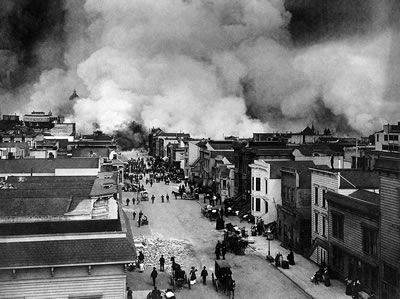Earthquakes are among the most devastating natural events that occur on Earth and are a reminder that our planet is a dynamic, changing body.
The term "earthquake" has two uses: it may denote the earth tremors (and the resultant damage) at a particular locality, or it may be used to describe the precise source of the tremors caused by a sudden fracture of the ground elsewhere.
There are two corresponding measures of the severity of an earthquake. Intensity (usually assessed on the 12-point Modified Mercalli Scale) is a measure of the local effect, which varies according to both the distance from the source of the earthquake and the intrinsic strength of the earthquake.
Magnitude is a measure of the strength of the earthquake at its source (focus). It is assessed on the Richter Scale, on which magnitude 7 is severe, magnitude 8 devastating.
Since 1904, when seismometers first provided data from which magnitudes could be calculated, there have been very few earthquakes exceeding magnitude 8.4.
The largest recorded earthquake occurred in Chile in 1960 and had a magnitude of 8.9 - approximately as powerful as a 100-megaton explosion.
Earthquakes Causes
Most earthquakes occur in narrow belts along the boundaries of crustal plates, particularly where the plates push together (as in the Himalayas, Andes and Japan) or slide past each other (as happens along the San Andreas Fault in California).
Earthquakes may be caused by movement of the plates, itself resulting from convection currents in the hot fluids of the mantle (the layer beneath the Earth's crust).
Some earthquakes are associated with volcanic activity and are caused by the welling-up or retreat of magma. Collapses of mines or caverns can also produce small earthquakes.
Earthquakes occur when rocks are subjected to stresses that they are not strong enough to withstand; as a result the rocks break down, thereby releasing the accumulated pressure, which then spreads out in waves from the point of breakdown and produces the earth tremors.
The difference between large and small earthquakes is not due chiefly to differences in the strengths of the different types of rocks, but rather to the amount of rock under stress.
In the 1964 Alaskan earthquake, for example, the stress was released over a region 800km long and, with such a large amount of rock involved, the earthquake itself was severe, having a magnitude of 8.6.
Along some parts of the San Andreas Fault earthquakes are frequent but small because stress accumulates over only a small amount of rock before it is released. A considerable amount of movement occurs along other areas of the fault without producing earthquakes. Yet other parts of the fault - around San Francisco for example - are "locked" at present, although surveys have shown that stress is accumulating and eventually the rocks will break down, producing a devastating earthquake - probably as severe as that of 1906, which had a magnitude of about 8.3 and completely destroyed San Francisco.
Earthquakes Effects
 The effects of an earthquake vary enormously, depending on its strength and on the distance from its epicenter. Some are so minor as to be detectable only with sensitive instruments. In contrast, a large earthquake can devastate a huge area, its effects being felt hundreds of kilometers from the epicenter.
The effects of an earthquake vary enormously, depending on its strength and on the distance from its epicenter. Some are so minor as to be detectable only with sensitive instruments. In contrast, a large earthquake can devastate a huge area, its effects being felt hundreds of kilometers from the epicenter.
Most direct damage results from shaking of the ground by earthquake (seismic) waves that move through the surface layers - called L waves. (Earthquakes also produce two other main types of waves - horizontally-moving primary, or P, waves, and vertically-moving secondary, or S, waves.)
Various side effects of the shaking include liquefaction of soft, damp ground, landslips and the appearance of large cracks in the surface.
When an earthquake occurs at sea, giant "tidal" waves (called tsunamis) may be produced by seismic disturbances of the sea floor. These waves can travel as fast as 750km/h and, as they reach the shore, may exceed 15m in height. They are so powerful that they can wreck relatively large buildings, sometimes for a considerable distance inland. The 2005 Sumatra earthquake, referred to as the Nias Earthquake by scientists after the island of Nias, caused a massively destructive tsunami and killed 1300 people, and is thought to be the second largest earthquake ever recorded at 8.7 on the Richter Scale.
Predicting Earthquakes
It is difficult to predict when earthquakes will happen. One approach to this problem involves studying the historical and geological records of a particular area in an attempt to discover a pattern in the frequency of earthquakes.
The records can reveal that they occur at comparatively regular intervals, which enables them to be predicted with reasonable accuracy. Usually, however, there is no easily recognizable pattern.
The other method of prediction involves studying various changes as the stress increases in the rocks of an earthquake-prone region. Many factors (including the shape of the ground, the physical properties of the rocks themselves, and even the behavior of animals) undergo characteristic changes that portend an earthquake but it is nevertheless extremely difficult to predict exactly when an earthquake will occur.